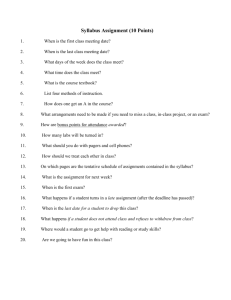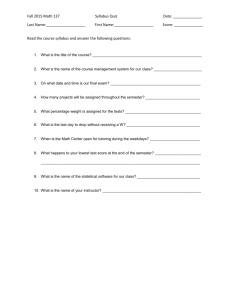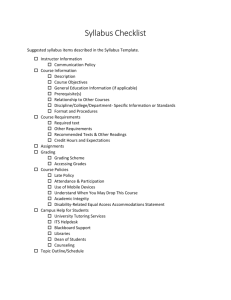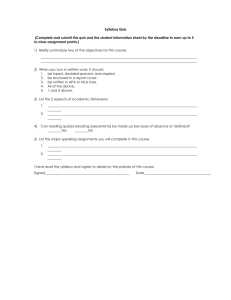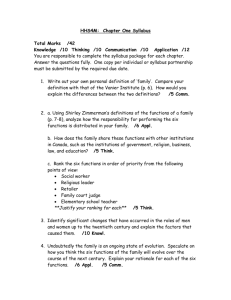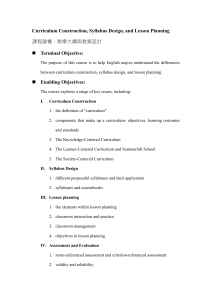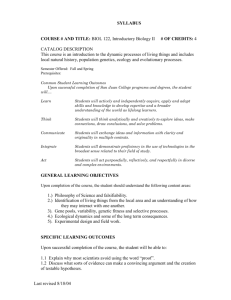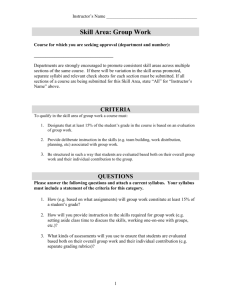AP US History Sample Syllabus 6 Accessible (ID#1387933v1)
advertisement
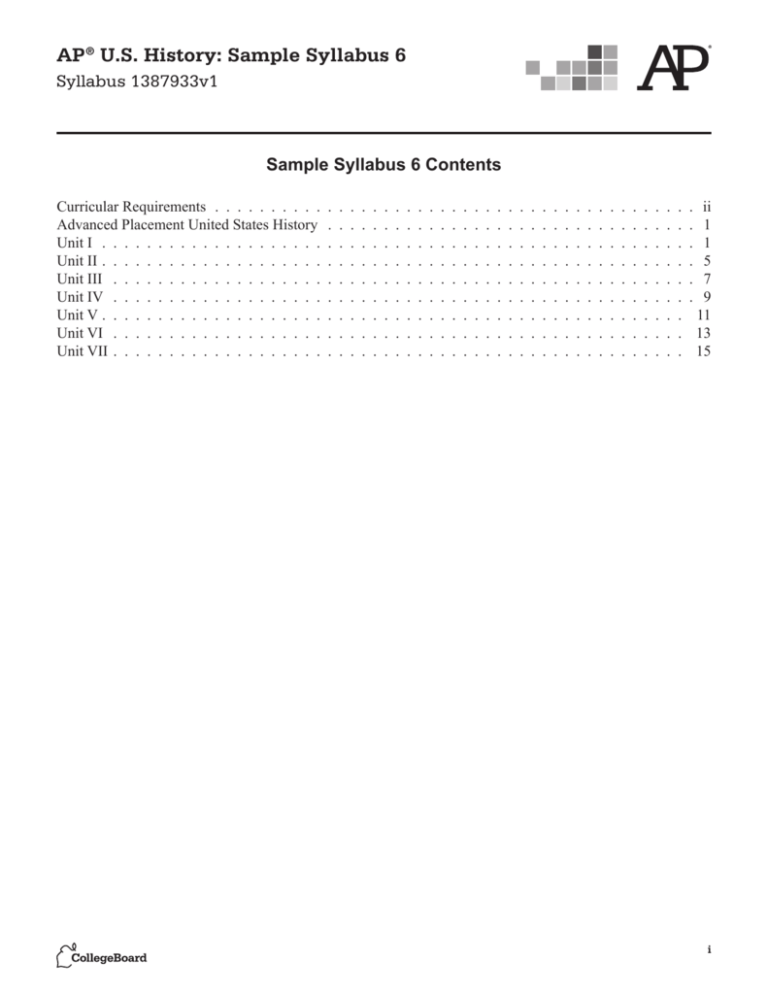
AP® U.S. History: Sample Syllabus 6 Syllabus 1387933v1 Sample Syllabus 6 Contents Curricular Requirements � � � � � � � � � � Advanced Placement United States History Unit I � � � � � � � � � � � � � � � � � � � � Unit II � � � � � � � � � � � � � � � � � � � � Unit III � � � � � � � � � � � � � � � � � � � Unit IV � � � � � � � � � � � � � � � � � � � Unit V � � � � � � � � � � � � � � � � � � � � Unit VI � � � � � � � � � � � � � � � � � � � Unit VII � � � � � � � � � � � � � � � � � � � � � � � � � � � � � � � � � � � � � � � � � � � � � � � � � � � � � � � � � � � � � � � � � � � � � � � � � � � � � � � � � � � � � � � � � � � � � � � � � � � � � � � � � � � � � � � � � � � � � � � � � � � � � � � � � � � � � � � � � � � � � � � � � � � � � � � � � � � � � � � � � � � � � � � � � � � � � � � � � � � � � � � � � � � � � � � � � � � � � � � � � � � � � � � � � � � � � � � � � � � � � � � � � � � � � � � � � � � � � � � � � � � � � � � � � � � � � � � � � � � � � � � � � � � � � � � � � � � � � � � � � � � � � � � � � � � � � � � � � � � � � � � � � � � � � � � � � ii 1 1 5 7 9 11 13 15 i AP® U.S. History: Sample Syllabus 6 Syllabus 1387933v1 Curricular Requirements CR1a The course includes a college-level U�S� history textbook� • See page 1 CR1b The course includes diverse primary sources consisting of written documents, maps, images, quantitative data (charts, graphs, tables), and works of art� • See pages 1, 3, 5, 7, 9, 11, 13, 14, 15, 17, 18 CR1c The course includes secondary sources written by historians or scholars interpreting the past� • See pages 1, 6, 8 CR2 Each of the course historical periods receives explicit attention� • See pages 1, 3, 5, 7, 9, 11, 13, 15, 17 CR3 Thecourseprovidesopportunitiesforstudentstoapplydetailedandspecificknowledge(suchasnames, chronology, facts, and events) to broader historical understandings� • See pages 4, 6, 8, 11, 12, 14, 15, 18 CR4 The course provides students with opportunities for instruction in the learning objectives in each of the seven themes throughout the course, as described in the AP U.S. History Curriculum Framework� • See pages 2, 6, 8, 10, 16, 18 CR5 The course provides opportunities for students to develop coherent written arguments that have a thesis supported by relevant historical evidence� — Historical argumentation • See pages 4, 6, 8, 11, 13, 15, 18 CR6 The course provides opportunities for students to identify and evaluate diverse historical interpretations� — Interpretation • See pages 4, 6, 8 CR7 The course provides opportunities for students to analyze evidence about the past from diverse sources, such as written documents, maps, images, quantitative data (charts, graphs, tables), and works of art� — Appropriate use of relevant historical evidence • See pages 1, 3, 5, 7, 9, 11, 13, 14, 15, 17 CR8 The course provides opportunities for students to examine relationships between causes and consequences of events or processes� — Historical causation • See pages 2, 8 CR9 The course provides opportunities for students to identify and analyze patterns of continuity and change over time and connect them to larger historical processes or themes� — Patterns of continuity and change over time • See pages 4, 17, 18 CR10 The course provides opportunities for students to investigate and construct different models of historical periodization� — Periodization • See pages 11, 16 CR11 The course provides opportunities for students to compare historical developments across or within societies in various chronological and geographical contexts� — Comparison • See pages 2, 3, 6 ii AP® U.S. History: Sample Syllabus 6 Syllabus 1387933v1 Curricular Requirements CR12 Thecourseprovidesopportunitiesforstudentstoconnecthistoricaldevelopmentstospecificcircumstances of time and place, and to broader regional, national, or global processes� — Contextualization • See page 2 CR13a The course provides opportunities for students to combine disparate, sometimes contradictory evidence from primary sources and secondary works in order to create a persuasive understanding of the past� — Synthesis • See pages 5, 6, 8, 10, 11, 12, 14, 15, 19 CR13b The course provides opportunities for students to apply insights about the past to other historical contexts or circumstances, including the present� — Synthesis • See page 6 iii AP® U.S. History Sample Syllabus 6 Syllabus 1387933v1 Advanced Placement United States History Textbook Henretta, James A�, Eric Hinderaker, Rebecca Edwards, and Robert O� Self� America’s History� 8th ed� Boston: Bedford/St� Martin’s, 2014� [CR1a] [CR1a]—The course includes a college-level U�S� history textbook� Secondary Sources [CR1c] Davidson, James West, and Mark Hamilton Lytle� After The Fact: The Art Of Historical Detection� New York: McGraw-Hill, 2000� Davis, Kenneth, Don’t Know Much About History: Everything You Need to Know about American History but Never Learned� New York: Harper Collins, 2003� Madaras, Larry, and James M� SoRelle� Taking Sides: Clashing Views on Controversial Issues in American History� 7th ed� 2 vols� Dubuque, IA: William C� Brown Company, 1997� [CR1c]—The course includes secondary sources written by historians or scholars interpreting the past� Unit I (5 weeks) Period 1: 1491–1607 & Period 2: 1607–1754 [CR2] [CR2]—Each of the course historical periods receives explicit attention� The Americas and the encounter: On the North American continent controlled by American Indians, contact between American Indians, Europeans, and Africans created a new world� Period 1: 1491-1607 (2 weeks) [CR2] [CR2]—Each of the course historical periods receives explicit attention� Readings Henretta et al�, chapters 1 & 2 (pp� 6–47) Davis, pp� 1–32 Activities Document Comparison and Analysis – Purpose, Historical Context, Intended Audience, Author’s Point of View (PHIA) Students use PHIA to analyze one or more of the sources below during an in-class writing assignment� [CR1b] [CR7] • • • • • • • Woodcut picture of North American economy after 1500 Christopher Columbus’s Fourth Journal Memoir of Jacques Cartier Images from El Lienza de Tlaxcala Second letter of Hernan Cortez to Emperor Charles V Gerard Mercators’ letter to Abraham Ortelius Legal Statement by Pedro Hildago, Soldier Excerpts from Spanish trial of the Pueblo Revolt 1 AP® U.S. History Sample Syllabus 6 Syllabus 1387933v1 [CR1b]—The course includes diverse primary sources consisting of written documents, maps, images, quantitative data (charts, graphs, tables), and works of art� [CR7]—The course provides opportunities for students to analyze evidence about the past from diverse sources, such as written documents, maps, images, quantitative data (charts, graphs, tables), and works of art� — Appropriate use of relevant historical evidence� Historical Scholarship Analysis: Podcast – Pueblo Revolt (http://www�missedinhistory�com/blog/missed-in-history-the-pueblo-revolt/) Students will analyze the two excerpts and listen to the podcast and evaluate their thesis, evidence, reasoning, and respond to these in an essay focusing on the demographic and economic changes during the Pueblo Revolt� Students will write an essay in response to the question “What events led up to the Pueblo Revolt and what were the effects of the Pueblo Revolt on the New World?”(POL-1) [CR4] [CR8] [CR4]—The course provides students with opportunities for instruction in the learning objectives in each of the seven themes throughout the course, as described in the AP U.S. History Curriculum Framework� [CR8]—The course provides opportunities for students to examine relationships between causes and consequences of events or processes� — Historical causation Six Degrees of Separation: Students will be provided with two events spanning decades, but related by their theme� They will select six events inchronologicalorderthatlinkthefirsteventintheserieswiththelast.Studentswillwritethenameofeachselected event, and use their research and knowledge of the time period to create an argument to support the events selected� Students must emphasize both cause and effect and/or demonstrate continuity or change over time in their linking� There will be at least one Six Degrees assignment per unit� Some events can and will include environmental impact data� This assignment provides students with the opportunity to observe continuity and change over time� [CR8] [CR8]—The course provides opportunities for students to examine relationships between causes and consequences of events or processes� — Historical causation From 1491 to Jamestown Students write an essay in which they evaluate the impact of the Columbian Exchange on Native Americans in North America during the 16th century� [CR12] [CR12]—The course provides opportunities for students to connect historical developments to specific circumstances of time and place, and to broader regional, national, or global processes� — Contextualization Working in groups, students develop a class presentation that analyzes reasons for the development of different labor systems in any two of the following regions of British colonial settlement: New England, the Chesapeake, the southernmost Atlantic coast, and the British West Indies� (WXT-4) [CR4] [CR11] [CR4]—The course provides students with opportunities for instruction in the learning objectives in each of the seven themes throughout the course, as described in the AP U.S. History Curriculum Framework� [CR11]—The course provides opportunities for students to compare historical developments across or within societies in various chronological and geographical contexts� — Comparison 2 AP® U.S. History Sample Syllabus 6 Syllabus 1387933v1 Period 2: 1607–1754 (3 weeks) [CR2] [CR2]—Each of the course historical periods receives explicit attention� Readings Henretta et al�, chapters 2–4 (pp� 47–135) Davis, pp� 33–41 Madaras and SoRelle, pp� 44–62 “Was Salem Witch Craft Hysteria Caused by a Fear of Women?” Yes: Carol Karlsen; No: Kai Erikson Activities Document Comparison and Analysis – Purpose, Historical Context, Intended Audience, Author’s Point of View (PHIA) Students use PHIA to analyze the one or more of the sources below during an in-class writing assignment� [CR1b] [CR7] • • • • • • • • • • • • • • • • • Samuel de Champlain and Algonquin Allies Fighting an Iroquois Army John Martin’s proposal for subjugating Native Americans TheMayflowerCompact Winthrop, “A Model of Christian Charity” Captain John Mason, A Brief History of the Pequot War Virginia Slave Laws (1662–1669) George Washington’s speech to Half-King and the Seneca tribe Second Navigation Act of 1663 John Locke, Second Treatise on Civil Government JohnColletGeorgeWhitefieldpreaching” GeorgeWhitefield,“SermonXXIII” BenjaminFranklinonGeorgeWhitefield TheMayflowerCompact Winthrop, “A Model of Christian Charity” Captain John Mason, A Brief History of the Pequot War Nathaniel Bacon’s Declaration against Gov� Berkeley Virginia Slave Codes (1677–1705) [CR1b]—The course includes diverse primary sources consisting of written documents, maps, images, quantitative data (charts, graphs, tables), and works of art� [CR7]—The course provides opportunities for students to analyze evidence about the past from diverse sources, such as written documents, maps, images, quantitative data (charts, graphs, tables), and works of art� — Appropriate use of relevant historical evidence� Six Degrees of Separation: From Jamestown to the French and Indian War� Working in groups, students develop a class presentation that analyzes reasons for the development of different labor systems in any two of the following regions of British colonial settlement: New England, the Chesapeake, the southernmost Atlantic coast, and the British West Indies� [CR11] 3 AP® U.S. History Sample Syllabus 6 Syllabus 1387933v1 [CR11]—The course provides opportunities for students to compare historical developments across or within societies in various chronological and geographical contexts� — Comparison Students will complete a Semantic Features Chart comparing England, France, and Spain during the period of exploration and colonization� Once the chart is completed, students will write a short essay on the following: Choose ONE of the nationalities below and explain why your choice best represents how it impacted the Native Americans culturally and economically� Provide ONE piece of evidence to support your explanation for culture and ONE for economic� • British • French • Spanish Contrast your choice against ONE of your other options, demonstrating why that option is not a good choice� Classroom Discussion – Students will evaluate the perspectives of Karlsen and Erikson and develop three main arguments, supporting evidence on the question: “Was Salem witchcraft hysteria caused by a fear of women?” They will form into pro and con sides and participate in a class discussion on the topic� The pro side: Carol F Karlsen, from The Devil in the Shape of a Woman: Witchcraft in Colonial New England; the con side: Kai T� Erikson, from Wayward Puritans: A Study in Sociology of Deviance. [CR6] [CR6]—The course provides opportunities for students to identify and evaluate diverse historical interpretations� — Interpretation Colonial Pamphlet – Students will develop a stock prospectus on why an investor should invest in one of the colonial regions (northern, middle or southern colonies) and then choose one other region and explain why an investor should not invest in that region� Students will create a narrative timeline on the evolution of self-governance in colonial America from 1607–1754 and analyze continuities and changes in self-government over time� [CR3] [CR9] [CR3]—The course provides opportunities for students to apply detailed and specific knowledge (such as names, chronology, facts, and events) to broader historical understandings� [CR9]—The course provides opportunities for students to identify and analyze patterns of continuity and change over time and connect them to larger historical processes or themes� — Patterns of continuity and change over time Assessment Multiple-Choice Questions Short Answer Questions – Students will use detailed knowledge, such as names, chronology, facts and events to answer two questions on the following reading: “The Native American Town of Secota; Rebellions, Revolts, Uprisings, Protests, 1491–1740�” [CR3] [CR3]—The course provides opportunities for students to apply detailed and specific knowledge (such as names, chronology, facts, and events) to broader historical understandings� Long Essay Question – In response to the following prompt, students will construct a historical argument with a thesis supported by historical evidence: “Analyze the role of trans-Atlantic trade and Great Britain’s mercantilist policies in the economic development of the British North American colonies in the period from 1650 to 1750�” [CR5] 4 AP® U.S. History Sample Syllabus 6 Syllabus 1387933v1 [CR5]—The course provides opportunities for students to develop coherent written arguments that have a thesis supported by relevant historical evidence� — Historical argumentation Document-Based Question – Students will read the sources from a DBQ on the Puritans� They will write an essay with a thesis statement supported by historical evidence that focuses on the economic, political, and religious values of the Puritans� [CR13a] [CR13a]—The course provides opportunities for students to combine disparate, sometimes contradictory evidence from primary sources and secondary works in order to create a persuasive understanding of the past� — Synthesis Unit II (4 weeks) Period 3: 1754–1800 [CR2] [CR2]—Each of the course historical periods receives explicit attention� Imperial competition produced a political revolution, a republic, and a continued struggle over the new nation’s social, political, and economic identity� Readings Henretta et al�, chapters 5–7, (pp� 135–231) and chapter 8 (pp� 257–268 and 269–277) Davis, pp� 41–100 Madaras and SoRelle, pp� 112–128 “Was the American Revolution a Conservative Movement?” Yes: Carl N� Degler; No: Gordon S� Wood Activities Document Comparison and Analysis – Purpose, Historical Context, Intended Audience, Author’s Point of View (PHIA) Students use PHIA to analyze one or more of the sources below during an in-class writing assignment� [CR1b] [CR7] • • • • • Benjamin Franklin, “Join, or Die” Cartoon Map of Proclamation of 1763 Excerpts from Thomas Paine’s, Common Sense Excerpt from the Declaration of Independence Excerpts from the Articles of Confederation • Federalist No� 10 • Anti-Federalist No� 5 • Abigail Adams’s letters to John Adams • Diagram of Hamilton’s Financial Plan [CR1b]—The course includes diverse primary sources consisting of written documents, maps, images, quantitative data (charts, graphs, tables), and works of art� [CR7]—The course provides opportunities for students to analyze evidence about the past from diverse sources, such as written documents, maps, images, quantitative data (charts, graphs, tables), and works of art� — Appropriate use of historical evidence� 5 AP® U.S. History Sample Syllabus 6 Syllabus 1387933v1 Classroom Discussion – Students will develop three main arguments with supporting evidence for a pro or con classroom discussion on the topic, “Was the American Revolution a conservative movement?” The pro side: Carl N� Degler from Out of Our Past: The Forces The Shaped Modern America; the con side: Gordon S� Wood from The Radicalism of the American Revolution [CR1c] [CR6] [CR1c]—The course includes secondary sources written by historians or scholars interpreting the past� [CR6]—The course provides opportunities for students to identify and evaluate diverse historical interpretations� — Interpretation Six Degrees of Separation: Drawing on assigned secondary sources, students will indicate the extent to which there is both continuity and change of basic civil rights from the Declaration of Independence to the Voting Rights Act of 1965� [CR13b] [CR13b]—The course provides opportunities for students to apply insights about the past to other historical contexts or circumstances, including the present� — Synthesis Students will create a “double bubble” thinking map on Shays’s Rebellion versus the Whiskey Rebellion� Then they will write an essay on the topic, “Settlers in the 18th-century backcountry sometimes resorted to violent protest to expressgrievances.Analyzethecausesandsignificanteffectsofbothevents.Rankwhichoneepitomizesthequote and justify your reason for your ranking�” [CR11] [CR11]—The course provides opportunities for students to compare historical developments across or within societies in various chronological and geographical contexts� — Comparison Students look at primary and secondary sources on the Articles of Confederation and U�S� Constitution, and they then debatethedegreetowhichtheConstitutionreflectedanemergingsenseofAmericannationalidentity.(ID-1) [CR4] [CR4]—The course provides students with opportunities for instruction in the learning objectives in each of the seven themes throughout the course, as described in the AP U.S. History Curriculum Framework� Assessment Multiple-Choice Questions Short Answer Questions – Students will use detailed knowledge such as names, chronology, facts and events to answer two questions on the following topics: “American Identity, 1763–1788” and “Hamilton’s Financial Plan�” [CR3] [CR3]—The course provides opportunities for students to apply detailed and specific knowledge (such as names, chronology, facts, and events) to broader historical understandings� Long Essay Question – In response to the following prompt, students will construct an historical argument with a thesis supported by historical evidence: “Analyze the effect of the French and Indian War and its aftermath on the relationshipbetweenGreatBritainandtheBritishcolonies.Confineyourresponsetotheperiodfrom1754to1776.” [CR5] [CR5]—The course provides opportunities for students to develop coherent written arguments that have a thesis supported by relevant historical evidence� — Historical argumentation Document-Based Question – In response to the following prompt, students will write an essay with a thesis statement supported by historical evidence that focuses on the economic, political, and social effects of the Revolution: “To what extent did the American Revolution fundamentally change American Society from 1775 to 1800?” [CR13a] [CR13a]—The course provides opportunities for students to combine disparate, sometimes contradictory evidence from primary sources and secondary works in order to create a persuasive understanding of the past� — Synthesis 6 AP® U.S. History Sample Syllabus 6 Syllabus 1387933v1 Unit III (5 weeks) Period 4: 1800–1848 [CR2] [CR2]—Each of the course historical periods receives explicit attention� Thenewrepublicstruggledtodefineandextenddemocraticideasinthefaceofrapideconomic,territorial,and demographic change� Readings Henretta et al�, chapters 7 and 8 (pp� 231–257 and 267–269) and 9 - 12 (pp� 280–405) Davis, pp� 100–126 Madaras and SoRelle, pp� 176–193 “Did the Bank War Cause the Panic of 1837?” Yes: Thomas P Govan; No: Peter Temin Activities Document Comparison and Analysis – Purpose, Historical Context, Intended Audience, Author’s Point of View (PHIA) Students use PHIA to analyze one or more of the sources below during an in-class writing assignment� [CR1b] [CR7] • • • • • • • • • • • • • Excerpts from Thomas Jefferson’s First Inaugural Address The “Ograbme” Cartoon Monroe Doctrine Andrew Jackson, “First Annual Message to Congress” President Jackson’s Bank Bill “Veto Message” JohnC.Calhoun’sArgumentonNullification John O’Sullivan on Manifest Destiny Thomas Corwin, “Against the Mexican War” William B� Travis, “Letter from the Alamo” “The Drunkard’s Progress” (cartoon) Excerpts from Ten Nights in a Barroom Exceprts from The Narrative of the Life of Frederick Douglass The Declaration of Sentiments [CR1b]—The course includes diverse primary sources consisting of written documents, maps, images, quantitative data (charts, graphs, tables), and works of art� [CR7]—The course provides opportunities for students to analyze evidence about the past from diverse sources, such as written documents, maps, images, quantitative data (charts, graphs, tables), and works of art� — Appropriate use of relevant historical evidence� Students will complete a concept map on the following four Marshall Court Decisions: 1� 2� 3� 4� Marbury v� Madison Mcculloch v� Maryland Dartmouth College v� Woodward Gibbons v� Ogden 7 AP® U.S. History Sample Syllabus 6 Syllabus 1387933v1 They then participate in a “Philosophical Chairs” activity� Classroom Discussion – Students will develop three main arguments with supporting evidence for a pro or con classroom discussion of the topic, “Did the Bank War Cause the Panic of 1837?” The pro side will read Thomas P� Govan, from “Fundamental Issues of the Bank War,” The Pennsylvania Magazine of History and Biography� The con side will read Peter Temin, from The Jacksonian Economy. [CR1c] [CR6] [CR1c]—The course includes secondary sources written by historians or scholars interpreting the past� [CR6]—The course provides opportunities for students to identify and evaluate diverse historical interpretations� — Interpretation Studentsaregivenanassignmenttoresearchoneantebellumreformmovementandexplainhowitfitintobroader patterns of antebellum reform� (POL-3) [CR4] [CR4]—The course provides students with opportunities for instruction in the learning objectives in each of the seven themes throughout the course, as described in the AP U.S. History Curriculum Framework� Six Degrees of Separation: From Jefferson to the Reform Era� StudentswillreflectontheSenecaFallsConvention:Inwhatwayswasitaconsequenceofpre-1848reformactivities and what did it contribute to the movement for women’s rights afterwards? Write an essay that makes an argument in response to this double-sided question� [CR8] [CR8]—The course provides opportunities for students to examine relationships between causes and consequences of events or processes� — Historical causation Assessment Multiple-Choice Questions Short-Answer Questions – Students will use detailed knowledge such as names, chronology, facts and events to answer two questions on the “King Andrew the First” cartoon and one on a quotation by historian Eric Foner on Cherokee removal� [CR3] [CR3]—The course provides opportunities for students to apply detailed and specific knowledge (such as names, chronology, facts, and events) to broader historical understandings. Long Essay Question – In response to the following prompt, students will construct a historical argument with a thesis supported by historical evidence: “How did the market revolution impact the three major regions (north, south and west) of the United States?” [CR5] [CR5]—The course provides opportunities for students to develop coherent written arguments that have a thesis supported by relevant historical evidence� — Historical argumentation Document-Based Question – In response to the following prompt, students will use the documents and their knowledge of the years from 1800 to 1855 to write an essay with a thesis statement supported by historical evidence: “The issue of territorial expansion sparked considerable debate in the period 1800 – 1855� Analyze this debate and evaluatetheinfluenceofbothsupportersandopponentsofterritorialexpansionin shaping federal government policy�” [CR13a] [CR13a]—The course provides opportunities for students to combine disparate, sometimes contradictory evidence from primary sources and secondary works in order to create a persuasive understanding of the past� — Synthesis 8 AP® U.S. History Sample Syllabus 6 Syllabus 1387933v1 Unit IV (4 weeks) Period 5: 1844–1877 [CR2] [CR2]—Each of the course historical periods receives explicit attention� As the nation expanded and its population grew, regional tensions, especially over slavery, led to a civil war — the course and aftermath of which transformed American society� Readings Henretta et al�, chapters 13–16 (pp� 406–539) Davis, pp� 127–165 and 181–189 Madaras and SoRelle, pp� 344–364 “Was Reconstruction a Success?” Yes: Kenneth Stampp; No: Eric Foner Activities Document Comparison and Analysis – Purpose, Historical Context, Intended Audience, Author’s Point of View (PHIA) Students use PHIA to analyze one or more of the sources below during an in-class writing assignment� [CR1b] [CR7] • • • • • • • • • John O’Sullivan, “Annexation” Thomas Corwin, “Against the Mexican War” Lincoln’s “Spot Resolutions” The handbill for the California gold rush The Wilmot Proviso cartoon Excerpts from The Narrative of the Life of Frederick Douglass Walt Whitman, “O Captain, My Captain” Mississippi’s Black Codes “A Sharecrop Contract” [CR1b]—The course includes diverse primary sources consisting of written documents, maps, images, quantitative data (charts, graphs, tables), and works of art� [CR7]—The course provides opportunities for students to analyze evidence about the past from diverse sources, such as written documents, maps, images, quantitative data (charts, graphs, tables), and works of art� — Appropriate use of relevant historical evidence� Classroom Discussion – Students will develop three main arguments with supporting evidence for a pro or con classroom discussion on the topic, “Was Reconstruction a Success?”� Who Freed the Slaves Lesson – Students will present their viewpoint on who freed the slaves, choosing from one of the following options: Congress, President Lincoln, the military, or African Americans� In addition, students will explain why the other three options were not as effective as their options� All students will do a close read of the article “Who Freed the Slaves?” by Barbara J� Fields, and complete a concept map� Each group will get a series of primary and secondary sources to support their claims: Lincoln • Speech at New Haven, March 6, 1860 9 AP® U.S. History Sample Syllabus 6 • • • • • • Syllabus 1387933v1 Letter to AH Stevens, December 22, 1860 Letter to WH Seward, February 1861 Letter to Horace Greeley, August 22, 1862 Emancipation Proclamation, January 1, 1863 Gettysburg Address, November 19, 1863 Second Inaugural Address, March 4, 1864 African Americans • William Henry Singleton, “Recollections of My Slavery Days” • Lincoln’s Letter to Horace Greeley, August 22, 1862 • GeneralBenjaminButler’slettertoWinfieldScott,May27,1861 • “African Americans in the Civil War” • Frederick Douglass, “Men of Color to Arms!” March 2, 1863 • T� W� Higginson, Letter to NY Times, February 14, 1864 • E� W� Hyde, Farewell Address to the Troops, February 9, 1866 Congress • Proposed amendment to the Constitution, March 2, 1861 • FirstConfiscationAct,August6,1861 • SecondConfiscationAct,July17,1862 • Militia Act, July 17, 1862 • Senator Charles Sumner argues for emancipation, May 1862 • 13thAmendment,ratifiedJanuary31,1865 Military • GeneralBenjaminButlertoGeneralinChiefWinfieldScott,May27,1861 • Annual Report of Secretary of War Simon Cameron, December 1, 1861 • Company E, 4th United States Colored Infantry, c� 1864 • David Hunter’s General Orders, May 9, 1862 • Abraham Lincoln to General Hunter, May 19, 1862 • Testimony by the Superintendent of Contrabands at Fortress, MO, May 9, 1863 Students read the sources in a document-based question on the Mexican-American War and engage in a classroom debate on President Polk’s motives for entering the war� (WOR-5) [CR4] [CR13a] [CR4]—The course provides students with opportunities for instruction in the learning objectives in each of the seven themes throughout the course, as described in the AP U.S. History Curriculum Framework� [CR13a]—The course provides opportunities for students to combine disparate, sometimes contradictory evidence from primary sources and secondary works in order to create a persuasive understanding of the past� — Synthesis 10 AP® U.S. History Sample Syllabus 6 Syllabus 1387933v1 Six Degrees of Separation activity: From The Liberator to the Compromise of 1877� Assessment Multiple-Choice Questions Short Answer Questions – Students will use detailed knowledge such as names, chronology, facts and events to answer two questions on the following topics: John Gast’s American Progress and Richard Hofstader, quote on the Emancipation Proclamation� [CR3] [CR3]—The course provides opportunities for students to apply detailed and specific knowledge (such as names, chronology, facts, and events) to broader historical understandings� Long Essay Question – In response to the following prompt, students will construct an historical argument with a thesis supported by historical evidence: “Assess the moral arguments and political actions of those opposed to the expansion of slavery in the context of TWO of the following: the Missouri Compromise, the Mexican War, the Compromise of 1850, the Kansas-Nebraska Act�” [CR5] [CR5]—The course provides opportunities for students to develop coherent written arguments that have a thesis supported by relevant historical evidence� — Historical argumentation Document-Based Question – In response to the following prompt, students will use the documents and their knowledge of the period from 1860 to 1877 to write an essay with a thesis statement supported by historical evidence: “In what ways and to what extent did constitutional and social developments between 1860 and 1877 amount to a revolution?” [CR10] [CR13a] [CR10]—The course provides opportunities for students to investigate and construct different models of historical periodization� — Periodization [CR13a]—The course provides opportunities for students to combine disparate, sometimes contradictory evidence from primary sources and secondary works in order to create a persuasive understanding of the past� — Synthesis Semester Break Unit V (4 weeks) Period 6: 1865–1914 [CR2] [CR2]—Each of the course historical periods receives explicit attention� The transformation of the United States from an agricultural to an increasingly industrialized and urbanized society broughtaboutsignificanteconomic,political,diplomatic,social,environmental,andculturalchange. Readings Henretta et al�, chapters 17–20 (pp� 540–567) Davis, pp� 257–283 and 289–303 Madaras and SoRelle, pp� 72–97, “Did the Progressives Fail?” Yes: Richard M Abrams; No: Arthur Link and Richard L� McCormick Activities Document Comparison and Analysis – Purpose, Historical Context, Intended Audience, Author’s Point of View (PHIA) Students use PHIA to analyze one or more of the sources below during an in-class writing assignment� [CR1b] [CR7] 11 AP® U.S. History Sample Syllabus 6 • • • • • • • • • Syllabus 1387933v1 Red Cloud’s Speech Excerpts from Huck Finn The Dawes Act “The Bosses of the Senate” cartoon Images from Jacob Riis’ How the Other Half Lives Petition to the Ohio state legislature against women suffrage Andrew Carnegie, “Wealth” Excerpts from Twenty Years at Hull House Excerpts from The Jungle [CR1b]—The course includes diverse primary sources consisting of written documents, maps, images, quantitative data (charts, graphs, tables), and works of art� [CR7]—The course provides opportunities for students to analyze evidence about the past from diverse sources, such as written documents, maps, images, quantitative data (charts, graphs, tables), and works of art� — Appropriate use of relevant historical evidence� Classroom Discussion – Students will develop three main arguments with supporting evidence for a pro or con classroom discussion on the topic, “Did the Progressives Fail?” Six Degrees of Separation activity: From the Homestead Act to the Battle of Wounded Knee� Populist Party Speech – Students will deliver a Populist Party Speech on why they should be the Populist Party presidential nominee in 1892� Students in groups of three to four will analyze various documents on the Populist Party and create their speech� Pullman Strike Lesson – Students will analyze two accounts of the Pullman Strike, one from the Chicago Times and the other from the Chicago Tribune� They will do a close reading of the article and conclude which newspaper supported the workers and which supported Pullman� Progressive Social Reformers’ Attitudes toward Immigrants Lesson – Reading excerpts from Jane Addams (2), Louise de Koven Bowen, and Hilda Satt Polacheck, students will decide if the progressive social reformers were generous and helpful or condescending and judgmental towards immigrants� Students will list three main points and give evidence of their support for each side� [CR13a] [CR13a]—The course provides opportunities for students to combine disparate, sometimes contradictory evidence from primary sources and secondary works in order to create a persuasive understanding of the past� — Synthesis Assessment Multiple-Choice Questions Short Answer Questions – Students will use detailed knowledge such as names, chronology, facts and events to answer two questions: one on “Compare the ideas of wealth: (1) The “Gospel of Wealth”; (2) quotation from Richard Hofstader in The American Political Tradition” and the other on “Urbanization in the U�S�, 1850 and 1890 population maps�” [CR3] [CR3]—The course provides opportunities for students to apply detailed and specific knowledge (such as names, chronology, facts, and events) to broader historical understandings� 12 AP® U.S. History Sample Syllabus 6 Syllabus 1387933v1 Long Essay Question – In response to the following prompt, students will construct a historical argument with a thesis supported by historical evidence: “How did the acquisition of natural resources factor in U�S� foreign policy decisions since the late 19th century, and were the resources the driving force in U�S� expansion?” [CR5] [CR5]—The course provides opportunities for students to develop coherent written arguments that have a thesis supported by relevant historical evidence� — Historical argumentation Document-Based Question – In response to the following prompt, students will use the documents and their knowledge of the period from 1870 to 1900 to write an essay with a thesis statement supported by historical evidence: “Inthepost–CivilWarUnitedStates,corporationsgrewsignificantlyinnumber,size,andinfluence.Analyzethe impactofbigbusinessontheeconomyandpoliticsandtheresponsesofAmericanstothesechanges.Confineyour answer to the period 1870 to 1900�” [CR5] [CR5]—The course provides opportunities for students to develop coherent written arguments that have a thesis supported by relevant historical evidence� — Historical argumentation Unit VI (6 weeks) Period 7: 1890–1945 [CR2] [CR2]—Each of the course historical periods receives explicit attention� An increasingly pluralistic United States faced profound domestic and global challenges, debated the proper degree of governmentactivism,andsoughttodefineitsinternationalrole. Readings Henretta et al�, chapters 21–24 (pp� 668–799) Davis, pp� 323–368, 388–396, 400–410, and 418–436 Madaras and SoRelle, pp� 198–218 “Were the 1920s an Era of Social and Cultural Rebellion?” Yes: William E� Leuchtenburg; No: David A� Shannon Madaras and SoRelle, “Was the New Deal an Effective Answer to the Great Depression?” Yes: Roger Biles; No: Gary Dean Best Activities Document Comparison and Analysis – Purpose, Historical Context, Intended Audience, Author’s Point of View (PHIA) Students use PHIA to analyze one or more of the sources below during an in-class writing assignment� [CR1b] [CR7] • • • • • • • • • Excerpt from Lincoln Steffens’, “The Shame of the Cities” Eulogy of Susan B� Anthony Early 1900s new transportation advertisements 1920s advertisements FDR’s Message to Congress recommending the Civilian Conservative Corps “Dear Mrs� Roosevelt” letters Espionage Act of 1917 Sedition Act of 1917 Eugene Deb’s speech condemning the Espionage Act and Sedition Act 13 AP® U.S. History Sample Syllabus 6 • • • • • • Syllabus 1387933v1 Various Langston Hughes poems U�S� Diplomatic cable to Spanish ambassador Platform of the American Anti-Imperialist League JosephBuffington,“FriendlyWordstotheForeignBorn” Arguments for and against the League of Nations Franklin D� Roosevelt, “Quarantine Speech” • Franklin D� Roosevelt, “Day of Infamy Speech” • • • • Walter Lippmann on Japanese internment Excerpts from Korematsu v. United States Fort Minor, “Kenji” President Truman’s “Decision to Drop the Atomic Bomb” documents [CR1b]—The course includes diverse primary sources consisting of written documents, maps, images, quantitative data (charts, graphs, tables), and works of art� [CR7]—The course provides opportunities for students to analyze evidence about the past from diverse sources, such as written documents, maps, images, quantitative data (charts, graphs, tables), and works of art� — Appropriate use of relevant historical evidence� Six Degrees of Separation activity: From The Sinking of the Maine to Hiroshima� Classroom Discussion – Students will develop three main arguments with supporting evidence for a pro or con classroom discussion on the topic, “Was the New Deal an Effective Answer to the Great Depression?” Students will construct a classroom presentation that argues one trial of the 1920s (Scopes, Leopold and Loeb, or Sacco and Vanzetti) that epitomizes the 1920s� In addition, the students will explain why the other two trials do not reflecttheessenceofthe1920s.[CR3] [CR3]—The course provides opportunities for students to apply detailed and specific knowledge (such as names, chronology, facts, and events) to broader historical understandings� Stock Market Crash Lesson – Students will be involved in an operating stock market in which they have an opportunity to make decisions based on stock data that will cause them to succeed or fail� Japanese Internment Lesson – Students will develop arguments on the topic, “Why were Japanese Americans interned during World War II?” Students will analyze the following: 1) a U�S� Government clip on Japanese interment (http://www�archive�org/details/Japanese1943); 2) the Munson Report and Harry Paxton Howard, “Americans in Concentration Camps,” from The Crisis; and 3) The Korematsu v. United States ruling and “Personal Justice Denied: The Report of the Commission on Wartime Relocation and Internment of Civilians�” For each document, students will complete the following: 1) reasons for internment suggested by this document and 2) evidence from this document to support these reasons� For each round develop a hypothesis on “Why were Japanese Americans interned during World War II?” [CR13a] [CR13a]—The course provides opportunities for students to combine disparate, sometimes contradictory evidence from primary sources and secondary works in order to create a persuasive understanding of the past� — Synthesis Assessment Multiple-Choice Questions 14 AP® U.S. History Sample Syllabus 6 Syllabus 1387933v1 Short Answer Questions – Students will use detailed knowledge such as names, chronology, facts, and events to answer two questions on the following sources: “The World’s Constable” cartoon and two secondary sources on the NewDeal—DavidH.Bennett,“SignificantChange,”1994andBartonBernstein,Towards a New Past� [CR3] [CR3]—The course provides opportunities for students to apply detailed and specific knowledge (such as names, chronology, facts, and events) to broader historical understandings� Long Essay Question – “To what extent were the policies of the New Deal a distinct turning point in U�S� history, andtowhatextentweretheymerelyanextensionofProgressiveErapolicygoals?Confineyouranswertoprograms/ policiesthataddressedthespecificneedsofAmericanworkers.”Studentswillconstructahistoricalargumentwitha thesis supported by historical evidence� [CR5] [CR5]—The course provides opportunities for students to develop coherent written arguments that have a thesis supported by relevant historical evidence� — Historical argumentation Document-Based Question – In response to the following prompt, students will use the documents and their knowledge of the period from 1939 to 1947 to write an essay with a thesis statement supported by historical evidence: “The United States decision to drop an atomic bomb on Hiroshima was a diplomatic measure calculated to intimidate the Soviet Union in the post–Second World War era rather than a strictly military measure designed to force Japan’s unconditional surrender� Evaluate this statement using the documents and your knowledge of the military and diplomatic history of the years 1939 through 1947� Students will use the documents and their knowledge of the period from 1939 to 1947�” [CR13a] [CR13a]—The course provides opportunities for students to combine disparate, sometimes contradictory evidence from primary sources and secondary works in order to create a persuasive understanding of the past� — Synthesis Unit VII (6 weeks) Period 8: 1945–1980 & Period 9: 1980–present [CR2] [CR2]—Each of the course historical periods receives explicit attention� PERIOD 8: 1945–1980 (4 weeks) [CR2] [CR2]—Each of the course historical periods receives explicit attention� After World War II, the United States grappled with prosperity and unfamiliar international responsibilities, while struggling to live up to its ideals� Readings Henrettaet al�, chapters 25–29 (pp� 800–967) Davis, pp� 418–463 and 483–507 Madaras and SoRelle, pp� 294–316, “Were the 1950s America’s ‘Happy Days’”? Yes: Melvyn Dubofsky and Athan Theoharis; No: Douglas Miller and Marion Nowak Activities Document Comparison and Analysis – Purpose, Historical Context, Intended Audience, Author’s Point of View (PHIA) Students use PHIA to analyze one or more of the sources below during an in-class writing assignment� [CR1b] [CR7] • George Kennan’s long telegram 15 AP® U.S. History Sample Syllabus 6 • • • • • • • • Syllabus 1387933v1 Truman Doctrine Interrogation of Peter Seeger by HUAC Gulf of Tonkin Resolutions Tim Driscoll’s “There Really Is a War” letter from Vietnam House Judiciary Committee’s Conclusion on Impeachment, 1974 Jimmy Carter, “Inaugural Address” Ronald Reagan, “Evil Empire” Bob Dylan songs • Vietnam War protest songs • • • • • Excerpts from The Feminine Mystique Martin Luther King Jr�, “Letter from a Birmingham Jail” Shirley Chisholm, “Equal Rights for Women” The American Indian movement’s “20-Point Proposal” Excerpt from Silent Spring [CR1b]—The course includes diverse primary sources consisting of written documents, maps, images, quantitative data (charts, graphs, tables), and works of art� [CR7]—The course provides opportunities for students to analyze evidence about the past from diverse sources, such as written documents, maps, images, quantitative data (charts, graphs, tables), and works of art� — Appropriate use of relevant historical evidence� Six Degrees of Separation activity: From Containment to “Tear Down This Wall�” Classroom Discussion – Students will develop three main arguments with supporting evidence for a pro or con discussion on the topic, “Were the 1950s America’s ‘Happy Days?’” Coffee House Lesson – After reading and discussing beatnik poetry (Allen Ginsberg, Lawrence Ferlinghetti, Gregory Corso, and Gary Snyder), students will write their own beatnik poems on an issue of the 1950s� Origins of the Cold War Class Debate Topic – “Some scholars argue that the Cold War started with the Russian Revolution� Examine primary and secondary sources and make a case for the Cold War starting in 1945 or 1917�” [CR10] [CR10]—The course provides opportunities for students to investigate and construct different models of historical periodization� — Periodization Shootings at Kent State Lesson – Students will close read “The Shooting at Kent State” by Tom Grace and listen to “What Really Happened at Kent State” (http://www�missedinhistory�com/podcasts/what-really- happened-at-kentstate/).Theywillwritetwoeditorials:thefirsteditorialwilladdresswhythegovernmenthadtherighttoallowthe NationalGuardtofireonthestudentsandthesecondwilladdresswhythefiringwaswrong. Students write an essay debating the role of popular music in affecting public attitudes toward the Vietnam War� (CUL-6) [CR4] [CR4]—The course provides students with opportunities for instruction in the learning objectives in each of the seven themes throughout the course, as described in the AP U.S. History Curriculum Framework� 16 AP® U.S. History Sample Syllabus 6 Syllabus 1387933v1 Demographic Map Analysis: Analyzing four maps of changing U�S� cities population (1920, 1940, 1960, and 1980) students will hypothesize why the frostbelt-nunbelt phenomenon transpired� [CR1b] [CR9] [CR1b]—The course includes diverse primary sources consisting of written documents, maps, images, quantitative data (charts, graphs, tables), and works of art� [CR9]—The course provides opportunities for students to identify and analyze patterns of continuity and change over time and connect them to larger historical processes or themes� — Patterns of continuity and change over time PERIOD 9: 1980-present (2 weeks) [CR2] [CR2]—Each of the course historical periods receives explicit attention� AstheUnitedStatestransitionedtoanewcenturyfilledwithchallengesandpossibilities,itexperiencedrenewed ideologicalandculturaldebates,soughttoredefineitsforeignpolicy,andadaptedtoeconomicglobalizationand revolutionary changes in science and technology� Readings Henretta et al�, chapters 30–31 (pp� 968–1035) Davis, pp� 510–587 Madaras and SoRelle, pp� 382–396, “Were the 1980s a Decade of Greed?” Yes: Kevin Phillips; No: Alan Reynolds Activities Document Comparison and Analysis – Purpose, Historical Context, Intended Audience, Author’s Point of View (PHIA) Students use PHIA to analyze one or more of the sources below during an in-class writing assignment� [CR1b] [CR7] • • • • • • • • • • • JimmyCarter,“CrisisofConfidence” 1980s car advertisements RonaldReagan,“RemarksontheAirTrafficControllers’Strike” Bill Clinton’s First Inaugural Address George W� Bush, Republican nomination acceptance speech Ronald Reagan, “Evil Empire” Ronald Reagan, “Support for the Contras” George W� Bush, “Presidential Address, September 20, 2001” Creation of Homeland Security Department documents Bill Clinton, “Address on Health Care Reform” Barack Obama, “Address to Congress on Health Care” [CR1b]—The course includes diverse primary sources consisting of written documents, maps, images, quantitative data (charts, graphs, tables), and works of art� [CR7]—The course provides opportunities for students to analyze evidence about the past from diverse sources, such as written documents, maps, images, quantitative data (charts, graphs, tables), and works of art� — Appropriate use of relevant historical evidence� 17 AP® U.S. History Sample Syllabus 6 Syllabus 1387933v1 Looking at economic data about employment, compensation, and household data broken down by race, gender, and education from the 1970s to 2010, students will write an essay that makes an argument about whether or not the American Dream existed� [CR1b] [CR1b]—The course includes diverse primary sources consisting of written documents, maps, images, quantitative data (charts, graphs, tables), and works of art� Students use a graphic organizer to compare and contrast the causes and goals of each act as described in excerpts from the 1924, 1965, and 1990 Immigration Acts� They ask what was the same and what was different in each historical period about the debate over immigration� (PEO-7) [CR4] [CR9] [CR4]—The course provides students with opportunities for instruction in the learning objectives in each of the seven themes throughout the course, as described in the AP U.S. History Curriculum Framework� [CR9]—The course provides opportunities for students to identify and analyze patterns of continuity and change over time and connect them to larger historical processes or themes� — Patterns of continuity and change over time Iconic Moments Lesson – The entire class composes a list of iconic moments or events associated with U�S� history in the period 1980 to the present� Students can begin with moments or events that occurred within their own lifetimes, but they should also include moments/events that cover the chronological span from 1980 to the present� The purpose of this exercise istodeepenthestudents’awarenessofspecificcontentwithinPeriod9.Next,studentswillcategorize the moments using the seven themes of AP U�S� History� [CR3] [CR3]—The course provides opportunities for students to apply detailed and specific knowledge (such as names, chronology, facts, and events) to broader historical understandings� Politics and Partisanship Lesson – Students will evaluate Presidents Clinton, Bush, and Obama with a T-Chart citing positive and negative aspects of their presidencies and assign each president a grade with a brief explanation of their criteria� Next, for each president, students will pick one event listed and compare it to an event from the 20th century� Then they will compare each president with another president prior to 1992� Finally, they will chart how the three presidents view the following topics: civil rights, immigration, technology, the economy, and the environment� [CR9] [CR9]—The course provides opportunities for students to identify and analyze patterns of continuity and change over time and connect them to larger historical processes or themes� — Patterns of change and continuity over time Students write a mock op-ed article for or against drilling for oil in the Arctic National Wildlife Refuge that cites precedents in U�S� law and history to justify their position� (ENV-5) [CR4] [CR4]—The course provides students with opportunities for instruction in the learning objectives in each of the seven themes throughout the course, as described in the AP U.S. History Curriculum Framework� Assessment Multiple-Choice Questions Short Answer Question – Students will use detailed knowledge such as names, chronology, facts and events to answer two questions on the following sources: Herblock’s “I am not a crook” Nixon cartoon and George W� Bush’s Oval OfficeAddress,September11,2001.[CR3] [CR3]—The course provides opportunities for students to apply detailed and specific knowledge (such as names, chronology, facts, and events) to broader historical understandings� Long Essay Question – In response to the following prompt, students will construct a historical argument with a thesis supported by historical evidence: “Compare the successes and failures of President Nixon’s, Reagan’s, and Carter’s domestic and foreign policies�” [CR5] 18 AP® U.S. History Sample Syllabus 6 Syllabus 1387933v1 [CR5]—The course provides opportunities for students to develop coherent written arguments that have a thesis supported by relevant historical evidence� — Historical argumentation Document-Based Question – In response to the following prompt, students will use the documents and their knowledge of the period from 1948 to 1961 to write an essay with a thesis statement supported by historical evidence: “What were the Cold War fears of the American people in the aftermath of the Second World War? How successfully did the administration of President Dwight D� Eisenhower address these fears?” [CR13a] [CR13a]—The course provides opportunities for students to combine disparate, sometimes contradictory evidence from primary sources and secondary works in order to create a persuasive understanding of the past� — Synthesis 19
